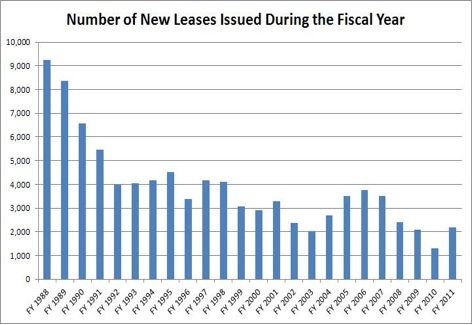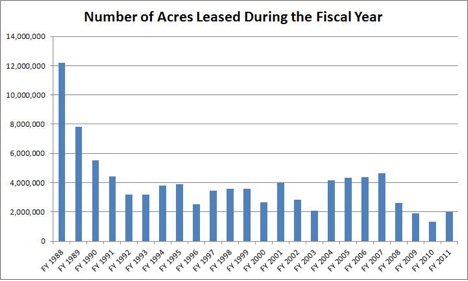While the Obama Administration is lollygagging regarding opening federal lands to oil and gas development, its Interior Department has been active in approving renewable projects on federal lands. As part of President Obama’s alleged “all-of-the-above” energy strategy, the U.S. Interior Department approved 27 wind, solar and geothermal projects on public lands since 2009, and the agency has an additional 17 projects to review this year.[i]
Unfortunately President Obama’s “all-of-the-above” energy plan, while a catch phrase that seems inclusive, does not cover oil and natural gas production on about 95 percent of federal lands and is hostile to coal use. For example, federal waters opened to oil and natural gas production in 2008 by President Bush and Congress are not included in the President’s 2012 to 2017 offshore leasing plan.[ii] In practical terms, the Offshore Drilling Moratorium in place between 1981 and 2008 will remain in place until at least 2017 under the Obama Administration leasing plans.
Renewable Approvals on Federal Lands
Since 2009 when President Obama took office, the Department of Interior approved 16 solar projects with 5,636 megawatts of capacity, 7 geothermal plants totaling 407 megawatts and 4 wind farms with capacity of 544 megawatts. In 2012, the agency plans to review 17 additional proposals (9 solar, 6 wind, and 2 geothermal) totaling about 7,000 megawatts.[iii]
In 2010, the Bureau of Land Management (BLM) approved 6 solar projects on federal lands in California and 3 in Nevada, and one wind project and 2 geothermal projects on federal lands in Nevada, totaling 3,900 megawatts and covering more than 60,500 acres of federal lands. A few projects overlap onto private lands using an additional 6,300 acres.[iv]
The Silver State North project (a 50 megawatt solar plant) in Nevada’s Ivanpah Valley, south of Las Vegas, is the first non-hydroelectric renewable plant to operate on federal soil. The solar plant started operating on Monday. It is owned by Enbridge Inc., Canada’s largest oil-pipeline company. NV Energy Inc., Nevada’s main electric utility, is committed to buying its power over the next 25 years.[v]
In 2011, the BLM gave priority status to 18 projects (9 solar, 4 wind, and 5 geothermal) totalling 4,279 megawatts. The projects include one solar project to be built on federal lands in Arizona, 7 in California, and one in Nevada; 2 wind projects each in California and Oregon; and 5 geothermal projects to be constructed on federal lands in Nevada. Decisions are pending on 2 projects and one has been identified as a priority project for 2012.[vi]
Offshore Wind Projects
The Obama Administration also promotes offshore wind projects, though their cost has shown them to be prohibitive compared to other renewable projects. The Energy Information Administration estimates the cost of generation from offshore wind to be 2.5 times more expensive than generation from onshore wind, and 3.7 more expensive than natural gas-fired combined cycle generation.
The Cape Wind project off Cape Cod, Massachusetts was the first offshore wind farm to get approval by the Department of Interior in 2010. But, the project is having trouble finding buyers for its high cost electricity. The second approved offshore wind project, Bluewater Wind owned by NRG Energy, off the coast of Delaware is having trouble getting financing.[vii] Although none have been built to date, Secretary of Interior Salazar wants to develop wind farms off the coasts of Maryland, Delaware, New Jersey, and Virginia.[viii]
The governors of five states and 10 federal agencies and departments have signed a memorandum of understanding to boost development of offshore wind energy in the Great Lakes. The governors of Illinois, Michigan, Minnesota, New York and Pennsylvania co-signed the memorandum of understanding, which requires federal agencies to streamline and expedite their current regulatory regimes for offshore wind projects. The Energy Department, one of the federal signees, estimates that the Great Lakes has the potential to produce more than 700 gigawatts of energy from offshore wind, about a fifth of the total offshore wind energy potential for the United States.[ix] However, while the winds may be there, so is the higher cost of producing the electricity.
Oil and Gas Approvals
While the Obama Administration is promoting all sorts of renewable technologies on public lands, fossil resource development on federal lands has fallen by the wayside. Oil production on federal and Indian lands has declined by 13 percent in fiscal year 2011 from fiscal year 2010 levels, while production on private and state lands has increased by 11 percent due to less bureaucratic red tape and the advent of hydraulic fracturing technology to get oil in shale formations.[x] Recent government impediments to oil production have included the denial of the Keystone XL pipeline, continued delays in Shell’s Arctic Alaska permits, and the moratorium and permitorium in the Gulf of Mexico after BP’s oil spill accident.
The federal government leases less than 2.2 percent of federal offshore areas and less than 6 percent of federal onshore lands for oil and natural gas production. When oil and gasoline prices peaked in 2008, President Bush and Congress allowed access to additional federal lands for oil and gas exploration. And, before leaving office, President Bush put forth a new 2010 to 2015 lease plan that included areas for leasing that had been off limits for almost 3 decades. The Obama Administration rejected that plan prior to the Macondo oil spill and since then has put forth delay after delay.
The Department of Interior now claims that its delay is because of the oil spill, though the Obama Administration had rejected a perfectly good plan prior to the spill. Due to the delays imposed by the Obama Administration, for the first time since the United States has had a comprehensive offshore leasing program, the 5 year plan will not be submitted in time to meet its statutory deadline and give Congress its 60 day review period.
The Obama administration did not hold a single offshore lease sale in fiscal year 2011, while the Bush administration planned to hold five. Those sales were rejected when the Obama Administration decided not to pursue the 2010 to 2015 outer continental shelf lease plan reflecting the expiration of the Presidential and Congressional moratoriums on leasing in 2008 demanded by the public.
President Obama’s Bureau of Land Management is setting records for the least number of leases on average per year. For example, President Clinton’s Administration issued over twice the number of leases per year than President Obama’s Administration issued (1856 leases), even though oil and gasoline prices were substantially lower during the Clinton Administration than the Obama Administration.
Oil and Gas Leases
Source: Bureau of Land Management, http://www.blm.gov/wo/st/en/prog/energy/oil_and_gas/statistics/Table04.html
The number of federal acres leased for oil and gas exploration and production has also taken a downturn under the Obama Administration. The number of federal acres leased during the Obama Administration averaged about 1,760,000 acres per annum, about half the acreage leased by either the Clinton Administration or the George W. Bush Administration.[xi]
Source: Bureau of Land Management, http://www.blm.gov/wo/st/en/prog/energy/oil_and_gas/statistics/Table05.html
Conclusion
The Obama Administration is fast tracking renewable energy development on federal lands, while delaying oil and natural gas resource development on federal lands. It is concentrating its limited resources on the most expensive kinds of energy for consumers, which may reflect its interpretation of President Obama’s statement that under his plans, “electricity prices will necessarily skyrocket.”
The Department of Interior has approved 27 projects for wind, solar, and geothermal electricity production since 2009 and 17 more are in review this year. In contrast, the Obama Administration has approved only half the leases per annum that the Clinton Administration approved and has taken the nation backward in its offshore leasing plan for 2012 to 2017, denying access to offshore areas opened for leasing by Congress and President Bush in 2008. In sum, the Obama Administration is force-feeding more expensive energy into the economy while starving Americans of the kinds of energy that they want to use. If Americans are concerned about energy costs, they should be concerned about these actions by the Obama Administration.
[i] Bloomberg, Salazar Activates First Solar Power Project on U.S. Land, May 7, 2012, http://www.bloomberg.com/news/2012-05-07/salazar-activates-first-solar-power-project-on-u-s-land.html
[ii] Institute for Energy Research, Obama’s Offshore Plan: One Giant Leap Backwards, May 8, 2012, https://www.instituteforenergyresearch.org/2012/05/08/obamas-offshore-plan-one-giant-leap-backwards/
[iii] Bloomberg, Salazar Activates First Solar Power Project on U.S. Land, May 7, 2012, http://www.bloomberg.com/news/2012-05-07/salazar-activates-first-solar-power-project-on-u-s-land.html
[iv] Bureau of Land Management, Renewable Energy Projects Approved in 2010, http://www.blm.gov/wo/st/en/prog/energy/renewable_energy/approved_projects.html
[v] Business Week, Official flips switch on solar plant near Vegas, May 8, 2012, http://www.businessweek.com/ap/2012-05/D9UKJHSO2.htm
[vi] Bureau of Land Management, 2011 Renewable Energy Priority Projects, http://www.blm.gov/wo/st/en/prog/energy/renewable_energy/priority_projects.html
[vii] Institute for Energy Research, Another Offshore Wind Project in Trouble, May 31,2011, https://www.instituteforenergyresearch.org/2011/05/31/another-offshore-wind-project-in-trouble/
[viii] ABC2 News, Salazar to make offshore wind announcement, February 2, 2012, http://www.abc2news.com/dpp/lifestyle/green/salazar-to-make-offshore-wind-announcement
[ix] Fox Business, Administration Aims to Harness Great Lakes Wind Energy, April 2, 2012, http://www.foxbusiness.com/industries/2012/04/02/administration-aims-to-harness-great-lakes-wind-energy/
[x] Congressional Research Service, U.S. Crude Oil Production in Federal and Non-Federal Areas, http://freebeacon.com/wp-content/uploads/2012/03/R42432.pdf
[xi] Bureau of Land Management, Oil and Gas Statistics, Table 5, http://www.blm.gov/pgdata/content/wo/en/prog/energy/oil_and_gas/statistics.html





